University Professor Geoffrey Ozin has won the prestigious Killam Prize for 2022 for his visionary work in the field of nanochemistry. The prize is awarded annually by the Canada Council for the Arts in recognition of the country’s “most inspiring scholars and thought leaders.”
“The occasion of the Killam Prize is a deeply appreciated honour,” says Ozin, a professor in the Faculty of Arts & Science’s Department of Chemistry. “It is a milestone in my fifty-two-year career contributing to frontier research in nanomaterials chemistry.”
Ozin earned his B.Sc. honours in chemistry at King’s College, University of London, and his D.Phil. in inorganic chemistry at Oxford University. He joined U of T as an assistant professor in 1969 and has held a Tier 1 Canada Research Chair in materials chemistry.
“Professor Ozin is an internationally recognized pioneer and leader in the field of nanochemistry and materials discovery,” says Robert Batey, chair of the Department of Chemistry. “His passion is the development of materials that can convert the greenhouse gas carbon dioxide into renewable renewable fuels using solar energy.”
“We are very proud and excited that Professor Ozin is receiving this honour,” says Leah Cowen, U of T’s Vice President of Research and Innovation, and Strategic Initiatives. “It is richly deserved — both for his foundational research into materials chemistry and for the transformational impact of that work in addressing the threat of climate change.”
Ozin’s paper, Nanochemistry – Synthesis in Diminishing Dimensions, published in 1992 in the journal Advanced Materials, laid the foundations for what is widely regarded as a scientific revolution in the application of nanochemistry in advanced materials science.\
“Every material is designed with a purpose,” he says. “There is no such thing as a bad material — a use can always be found. In my teachings, I talk about the iPhone, which would not exist without the discovery of the materials that make the mobile device work.”
Ozin’s groundbreaking research has made possible the development of renewable-energy technologies for synthesizing innovative chemicals, polymers, pharmaceuticals and fuels. It is enabling the development of lithium-ion batteries, supercapacitors, fuel cells and photovoltaics which are critical for transitioning from fossil fuels to renewable energy. It has also found applications in sustainable forms of transportation, agriculture and electricity generation that power a renewable energy infrastructure.
Ozin’s current research focus is driven by the climate crisis and is aimed at the discovery of materials capable of transforming water and carbon dioxide with sunlight into sustainable chemicals and fuels. As he and co-author Mireille Ghoussoub describe in their book The Story of CO2, the goal is to use CO2 as a “feedstock” for making chemicals presently made from fossil fuels. It can also be used to produce fuels such as methanol which would lessen the demand for newly extracted fossil fuels.
To this end, Ozin established the Solar Fuels Cluster at the University of Toronto, an interdisciplinary, international research team of chemists and engineers aimed at CO2 utilization and, ultimately, a renewable-energy-powered economy. He also co-founded the spin-off Solistra which is developing a chemical reactor, powered by sunlight, that can convert methane and carbon dioxide into commodity chemicals normally sourced from fossil fuels.
“Solid-state materials chemistry is a field with a long history,” says Ozin. “It is a truly multidisciplinary endeavour, requiring expertise and collaboration — in physics, biology and geology — to solve big problems, such as the existential challenges of climate change and plastic pollution, and these days a debilitating pandemic.
“Being allowed the freedom to creatively play for so long in this field has enabled the fruits of my nanomaterials research to find utility in renewable energy generation, storage and conversion,” he says. “Today, nanomaterials are ubiquitous in the advanced technologies leading the path towards a greener and more sustainable tomorrow.”


